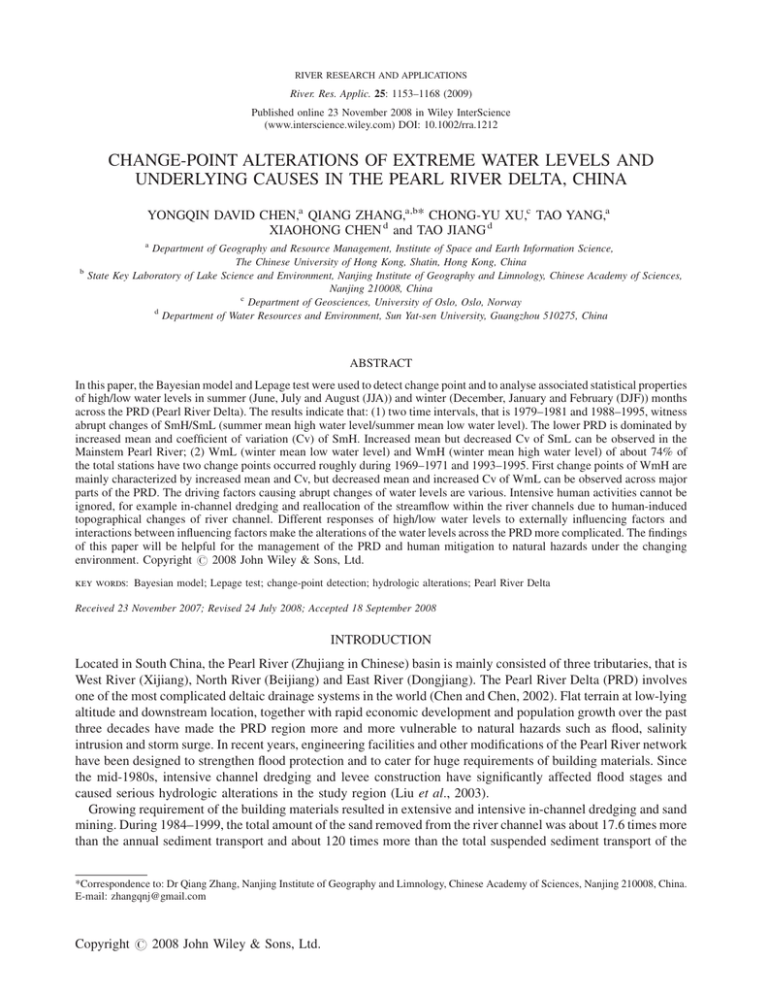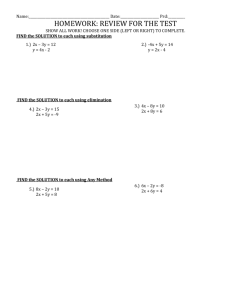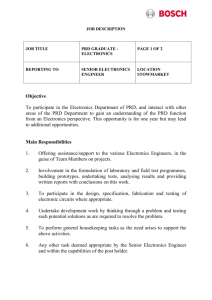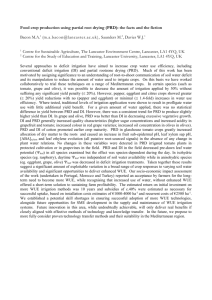River. Res. Applic. 25: 1153–1168 (2009) (www.interscience.wiley.com) DOI: 10.1002/rra.1212
advertisement

RIVER RESEARCH AND APPLICATIONS River. Res. Applic. 25: 1153–1168 (2009) Published online 23 November 2008 in Wiley InterScience (www.interscience.wiley.com) DOI: 10.1002/rra.1212 CHANGE-POINT ALTERATIONS OF EXTREME WATER LEVELS AND UNDERLYING CAUSES IN THE PEARL RIVER DELTA, CHINA YONGQIN DAVID CHEN,a QIANG ZHANG,a,b* CHONG-YU XU,c TAO YANG,a XIAOHONG CHEN d and TAO JIANG d a b Department of Geography and Resource Management, Institute of Space and Earth Information Science, The Chinese University of Hong Kong, Shatin, Hong Kong, China State Key Laboratory of Lake Science and Environment, Nanjing Institute of Geography and Limnology, Chinese Academy of Sciences, Nanjing 210008, China c Department of Geosciences, University of Oslo, Oslo, Norway d Department of Water Resources and Environment, Sun Yat-sen University, Guangzhou 510275, China ABSTRACT In this paper, the Bayesian model and Lepage test were used to detect change point and to analyse associated statistical properties of high/low water levels in summer (June, July and August (JJA)) and winter (December, January and February (DJF)) months across the PRD (Pearl River Delta). The results indicate that: (1) two time intervals, that is 1979–1981 and 1988–1995, witness abrupt changes of SmH/SmL (summer mean high water level/summer mean low water level). The lower PRD is dominated by increased mean and coefficient of variation (Cv) of SmH. Increased mean but decreased Cv of SmL can be observed in the Mainstem Pearl River; (2) WmL (winter mean low water level) and WmH (winter mean high water level) of about 74% of the total stations have two change points occurred roughly during 1969–1971 and 1993–1995. First change points of WmH are mainly characterized by increased mean and Cv, but decreased mean and increased Cv of WmL can be observed across major parts of the PRD. The driving factors causing abrupt changes of water levels are various. Intensive human activities cannot be ignored, for example in-channel dredging and reallocation of the streamflow within the river channels due to human-induced topographical changes of river channel. Different responses of high/low water levels to externally influencing factors and interactions between influencing factors make the alterations of the water levels across the PRD more complicated. The findings of this paper will be helpful for the management of the PRD and human mitigation to natural hazards under the changing environment. Copyright # 2008 John Wiley & Sons, Ltd. key words: Bayesian model; Lepage test; change-point detection; hydrologic alterations; Pearl River Delta Received 23 November 2007; Revised 24 July 2008; Accepted 18 September 2008 INTRODUCTION Located in South China, the Pearl River (Zhujiang in Chinese) basin is mainly consisted of three tributaries, that is West River (Xijiang), North River (Beijiang) and East River (Dongjiang). The Pearl River Delta (PRD) involves one of the most complicated deltaic drainage systems in the world (Chen and Chen, 2002). Flat terrain at low-lying altitude and downstream location, together with rapid economic development and population growth over the past three decades have made the PRD region more and more vulnerable to natural hazards such as flood, salinity intrusion and storm surge. In recent years, engineering facilities and other modifications of the Pearl River network have been designed to strengthen flood protection and to cater for huge requirements of building materials. Since the mid-1980s, intensive channel dredging and levee construction have significantly affected flood stages and caused serious hydrologic alterations in the study region (Liu et al., 2003). Growing requirement of the building materials resulted in extensive and intensive in-channel dredging and sand mining. During 1984–1999, the total amount of the sand removed from the river channel was about 17.6 times more than the annual sediment transport and about 120 times more than the total suspended sediment transport of the *Correspondence to: Dr Qiang Zhang, Nanjing Institute of Geography and Limnology, Chinese Academy of Sciences, Nanjing 210008, China. E-mail: zhangqnj@gmail.com Copyright # 2008 John Wiley & Sons, Ltd. 1154 Y. D. CHEN ET AL. Pearl River (Luo et al., 2000), which greatly altered channel shapes and the associated hydrologic processes within the river channels (Luo et al., 2007). In recent years, hydrologic alterations and the underlying causes have drawn increasing concerns from policy-makers and researchers and many relevant studies have been carried out (e.g. Huang et al., 2000; Luo et al., 2000; Yang et al., 2002; Liu et al., 2003; Chen et al., 2004). Based on tidal records of 54 tide gauges distributed across the delta plain, Huang et al. (2004) examined the increased potential risk of tidal inundation driven by sea level rise in the PRD. Xu (1998) found that the rising sea level in the estuary had led to obvious backwater effect which in turn further forced the flood stage upward. Several studies suggested a rather clear change in the deltaic hydrologic system in terms of both stage and discharge patterns in the early 1990s when human interferences reached a massive level (e.g. Chen and Chen, 2002). Given the increasing evidence of rising sea level and intensification of human activities, study on hydrological alternations will be greatly important for sustainable development and mitigation of natural hazards. Although the previous studies have analysed the changes of water levels and possible causes, several important scientific questions remain unanswered: (1) When did abrupt changes of water levels, if any, occur across the PRD region? (2) What are the statistical properties of water level before and after change point? and (3) What are the implications of abrupt changes of water level for water management in this rapidly changing environment? To address these questions, we have carried out this study to achieve the following three objectives: (1) identifying change points, if any, of the water level series across the PRD region; (2) analysing the statistical properties (mean and coefficient of variation (Cv)) of water levels before and after the change points and (3) examining the spatial patterns of water level statistics over the study region and elucidating the possible underlying causes. This study carries not only important scientific merits for understanding hydrologic alternations under massive human interferences in a very complicated delta, but also highly valuable practical significance for environmental management in the PRD region. STUDY REGION AND DATA Study region As mentioned earlier, three rivers (Xijiang, Beijiang and Dongjiang, literally West, North and East River) join together and form the PRD covering an area of 9750 km2 (Figure 1). The crisscross river network (density: 0.68– 1.07 km km2) in the PRD is one of the most complex deltaic drainage systems in the world. There are 424 cities and towns with a population of over 10 000 each in the region, including major cities such as Hong Kong, Macau and Guangzhou. The average distance between towns and cities is <10 km. With the rapid socio-economic development and urbanization, significant changes of the hydrological characteristics have taken place in the river network of the PRD over the past two decades. These changes should be mainly attributed to the combined effects caused by following human activities: sand dredging in the river, reclamation of former flood-afflicted areas, connection of dykes, construction of numerous bridges, docks and sluices along the river and irrational regulation of water locks. Human activities, along with strong riverbed scouring and sea level rise, respectively, give rise to riverbed degradation and stage reduction in the upper river reaches of the Delta but sedimentation and backwater resistance in the river mouths. Data Monthly mean high and low water level data from 1958 to 2005 were collected from 19 gauging stations in the PRD. Location of the gauging stations and detailed information of the data can be referred to Figure 1 and Table I, respectively. Table I presents the data series lengths vary and some stations have missing data within certain time periods. The missing data were filled up based on data of neighbouring stations using regression method (R2 > 0.8 and even R2 > 0.95). High water level usually occurs in high flow periods in summer (June, July and August (JJA)) and low water level usually occurs in low flow periods in winter (December, January and February (DJF)). High water level may cause flood hazards and low water level is usually closely related to salinity intrusion. As a result of channel and drainage system modification caused by human perturbation, water level and other hydrologic regimes may change abruptly and the statistical properties of time series segments divided by change points, if any, will Copyright # 2008 John Wiley & Sons, Ltd. River. Res. Applic. 25: 1153–1168 (2009) DOI: 10.1002/rra ALTERATIONS AND ABRUPT CHANGES OF WATER LEVEL 1155 Figure 1. Location of the Pearl River Delta in China and gauging stations. The river channels denoted with numbers are where the gauging stations are located. The names of the river channels are listed as follows. Region I, region II and region III divided by dashed lines are the upper, middle and lower PRD. 1, N. mainstem of Dongjiang; 2, Modaomen channel; 3, Hengmen channel; 4, Yamen channel; 5, Jitimen channel; 6, mainstem of Zhujiang; 7, Xijiang channel; 8, Xi’nanyong channel; 9, Ronggui channel; 10, Jiaomen channel; 11, Shunde channel; 12, Shawan channel; 13, Beijiang channel; 14, Tanjiang channel; 15, S. mainstem of Dongjiang; 16, Hongqili channel; 17, Xiaolan channel; 18, Hutiaomen channel; 19, Dongping channel; I, Upper Pearl River Delta; II, Middle Pearl River Delta; III, lower Pearl River Delta differ significantly from each other. Therefore, this study mainly focused on the detection and characterization of abrupt changes of mean high/low water levels in summer and winter, respectively. METHODS Numerous techniques have been developed and applied to detect and analyse abrupt changes in hydrologic and meteorological time series (e.g. Richter et al., 1996; Matsuyama et al., 2002; Mohammad-Djafari and Olivier, 2007). While this study did not aim to make comparison of these techniques, our first task was to identify and select appropriate and robust change-point analysis methods. Two techniques, that is Bayesian model and Lepage test, have been widely used by hydrologists and the literature has shown their pros and cons for evaluating hydrologic time series. Bayesian model is highly robust in identifying one single change point, but becomes less certain when multiple change points may exist (Chernoff and Zacks, 1963; Berger, 1985; Kotz and Wu, 2000; Xiong and Guo, 2004). On the other hand, Lepage test is theoretically capable of detecting multiple change points. However, the change points detected may vary when time windows of different lengths are adopted (Lepage, 1971). With Copyright # 2008 John Wiley & Sons, Ltd. River. Res. Applic. 25: 1153–1168 (2009) DOI: 10.1002/rra 1156 Y. D. CHEN ET AL. Table I. Dataset of the water levels in the Pearl River Delta and the river channels where the gauging stations are located along Station name Longitude Latitude Series length Upper PRD Sanshui Makou Middle PRD Jiangmen Laoyagang Nanhua Rongqi Sanduo Tianhe Xiaolan Lower PRD Dasheng Denglongshan Hengmen Huangchong Huangpu Nansha Sanshakou Sishengwei Xipaotai Zhuyin 1128500 1128480 238100 238070 1958–2005 1958–2006 1138070 1138120 1138050 1138160 1128590 1138040 1138140 1138320 1138240 1138310 1138040 1138280 1138340 1138300 1138360 1138070 1138170 228360 238140 228480 228470 228590 228440 228410 238030 228140 228350 228180 238060 228450 228540 228550 228130 228220 1958–2005 1958–2005 1958–2005 1958–2005 1958–2005 1958–1988 1975–2005 1958–2005 1959–2005 1959–2005 1961–2005 1958–2005 1963–2005 1958–2005 1958–2005 1958–2005 1959–2005 Missing data River channels Sep.-Dec. 1959; 1960 Sep.-Dec. 1959; 1966; 1968; Oct.-Dec. 1969 2000 Dec. 1959 Beijiang channel Xijiang channel Jun.-Dec. 1963 Jan.-Sep. 1958 2000–2005 1959 1964 1968–73 Xijiang channel Xi’nanyong channel Ronggui channel Ronggui channel Shunde channel Xijiang channel Xiaolan channel North mainstem East River Modaomen channel Hengmen channel Yamen channel Mainstem Zhujiang River Jiaomen channel Shawan channel South mainstem East River Hutiaomen channel Modaomen channel reference to past studies, we consider a combination of these two techniques which complement to each other would help us best to achieve our research objectives. Finally, it should be pointed out that the Bayesian model requires normality of water level time series and otherwise the Box–Cox transformation (Box and Jenkins, 1976) must be implemented to transform the original data series into a new series with a normal distribution (Xiong and Guo, 2004). Bayesian model Change-point detection for time series is an important research area in statistics and has been widely used in hydrologic analysis (Mohammad-Djafari and Olivier, 2007). The hydrologic series (x1,. . .,xn) is divided into two segments by a change point denoted as k (1 k < n). The two segments with mean values denoted as ma and mb are assumed to be normally distributed as xi Nðma; s 2 ÞI ¼ 1; 2; . . . ; k and xj Nðmb ; s 2 Þ; j ¼ k þ 1; 2; . . . ; n (1) If we focus on the shift in the mean value, we just take the mean value of the time series as a random variable following a certain distribution. Typically, the prior distributions of both ma and mb are assumed to be the same normal distribution given by ma Nðm0 ; s 20 Þ; mb Nðm0 ; s 20 Þ (2) when s 20 is large enough, the above normal distribution will approach the non-informative prior distribution (Xiong and Guo, 2004). Copyright # 2008 John Wiley & Sons, Ltd. River. Res. Applic. 25: 1153–1168 (2009) DOI: 10.1002/rra ALTERATIONS AND ABRUPT CHANGES OF WATER LEVEL 1157 The variance s2 can be regarded as a constant in the two segments and it can be estimated from the water level series. The distribution of the means ma and mb can be determined as (3) ma jXk ma P n m0 þ ki¼1 xi ; ¼ n þ k Nðma ; s 2 a Þ s 2 a ¼ s2 s2 ; n ¼ n þ k s 20 (5) mb jX kþ1 Nðmb ; s 2 b Þ mb ¼ P n m0 þ ni¼kþ1 xi ; n þ ðn kÞ s 2 b ¼ n (4) s2 s2 ; n ¼ 2 þ ðn kÞ s0 (6) The likelihood function based on Equation (1) can be formulated as " # " # n 1 ðxi ma Þ2 Y 1 ðxi mb Þ2 pffiffiffiffiffiffiffiffiffi exp pffiffiffiffiffiffiffiffiffi exp pðXjk; ma ; mb Þ ¼ 2s 2 2s 2 2ps i¼1 i¼kþ1 2ps k Y (7) Based on the Bayesian theorem, the posterior distribution of the change point k is derived as pðXjk; ma ; mb ÞpðkÞ pðkjX; ma ; mb Þ ¼ Pn1 j¼1 pðXj j; ma ; mb ÞpðjÞ (8) where p( j) represents the prior distribution of the change point k, and is often assumed to be a uniform distribution. The full conditional distribution of k can be estimated by Markov Chain Monte Carlo methods (e.g. Smith and Roberts, 1993). Detailed information of the computation procedure can be referred to Xiong and Guo (2004). Lepage test The Lepage test is a non-parametric, two-sample test for location and dispersion (Lepage, 1971). It has been widely used to detect changes such as long-term trends, cyclic variations and step-like changes for rainfall (Yonetani, 1993; Matsuyama et al., 2002; Benjamin and Roger, 2005). Following the x2 distribution with two degrees of freedom, the Lepage statistic (HK) is a sum of the squares of the standardized Wilcoxon’s and Ansari– Bradley’s statistics, that is HK ¼ ½W EðWÞ2 ½A EðAÞ2 þ VðWÞ VðAÞ (9) If HK exceeds 5.99 and 9.21, the difference between two sample means is judged as significant at 95% and 99% confidence level, respectively. HK is calculated as follows: let x ¼ (x1, x2,. . .,xn1) and y ¼ (y1, y2,. . .,yn2) be two independent samples of size n1 and n2. Assume that ui ¼ 1, if the ith smallest observation in a combined sample of the size (n1 + n2) belongs to x and ui ¼ 0 if it belongs to y.The terms in Equation (8) can be derived based on the Copyright # 2008 John Wiley & Sons, Ltd. River. Res. Applic. 25: 1153–1168 (2009) DOI: 10.1002/rra 1158 Y. D. CHEN ET AL. following equations: W¼ nX 1 þn2 iui (10) i¼1 n1 ðn1 þ n2 þ 1Þ 2 (11) n2 n1 ðn1 þ n2 þ 1Þ 2 (12) EðWÞ ¼ VðWÞ ¼ A¼ n1 X i¼1 nX 1 þn2 iui þ ðn1 þ n2 i þ 1Þui (13) i¼n1 þ1 If n1 + n2 is even, E(A) and V(A) will be estimated as n1 ðn1 þ n2 þ 2Þ 4 (14) n1 n2 ðn1 þ n2 2Þðn1 þ n2 þ 2Þ 48ðn1 þ n2 1Þ (15) EðAÞ ¼ VðAÞ ¼ If n1 + n2 is odd, E(A) and V(A) will be estimated as EðAÞ ¼ VðAÞ ¼ n1 ðn1 þ n2 þ 1Þ2 4ðn1 þ n2 Þ n1 n2 ðn1 þ n2 þ 1Þ½ðn1 þ n2 Þ2 þ 3 48ðn1 þ n2 Þ2 (16) (17) The statistical properties of time series segments divided by change points can be characterized by mean and Cv. The mean, mx, of a random variable, X, is its expected value. Thus, mx ¼ EðXÞ ¼ m01 (18) where m01 is the first moment about the origin. A sample estimate of the population mean is the arithmetic average,X, calculated from X¼ n X xi i¼1 n (19) A dimensionless measure of dispersion is the Cv, defined as the standard deviation divided by the mean. The Cv is estimated from sffiffiffiffiffiffiffiffiffiffiffiffiffiffiffiffiffiffiffiffiffiffiffiffiffiffiffiffiffi Pk 2 sx i¼1 ðxi xÞ Cv ¼ wheresx ¼ (20) x n1 Spatial interpolation Besides the temporal analysis for detecting abrupt changes of water level series, the spatial patterns of water level characteristics before and after change points must be analysed for understanding the spatio-temporal dynamics of hydrologic alternations across the entire study region. To generate water level surface from point-based values, Kriging, a commonly used geostatistical technique, was employed for spatial interpolation which was implemented Copyright # 2008 John Wiley & Sons, Ltd. River. Res. Applic. 25: 1153–1168 (2009) DOI: 10.1002/rra ALTERATIONS AND ABRUPT CHANGES OF WATER LEVEL 1159 Figure 2. Power of Lepage test and Bayes model in change-point detection. A: The normal plot of summer mean high water level of Sanduo station; B: the change point detected based on the Bayes model; C: the change point detected using Lepage test; D: three segments divided by the timing of the change point detected using Lepage test and Bayes model and related summer mean high level of each segments. The timing of the change point, after assessment of the results of the Lepage test and the Bayes model, is 1979 and 1992. The change point is significant at >95% confidence level using Surfer software (e.g. Goovaerts, 1999; Hartkamp et al., 1999; Sauquet, 2006). In fact, the Kriging interpolation method has already been applied in the study of water level changes within the PRD region (e.g. Chen et al., 2004; Zhang and Chen, 2004). RESULTS Lepage test and Bayesian model for change-point detection For illustrative purpose, a comparison of Lepage test and Bayesian model in change-point detection of summer mean high (SmH) water level data at Sanduo station is shown in Figure 2. An example of normality test for SmH is presented in Figure 2A, indicating that SmH of Sanduo station fits the normal distribution well (a straight line is fitted for the accumulated frequency on a normal distribution paper) and thus it is not necessary to perform Box– Cox transformation on the series. Figure 2B demonstrates the performance of Bayesian model in change-point analysis. The timing of 1979 has the highest probability and so it can be accepted as a change point. The next change point could be 1992, but no further information could be extracted from Figure 2B. Given the single change point detected by the Bayesian model, we used Lepage test to search for other possible change points. As shown in Figure 2C, at least three change points emerged after a series of Lepage tests with time windows of different Copyright # 2008 John Wiley & Sons, Ltd. River. Res. Applic. 25: 1153–1168 (2009) DOI: 10.1002/rra 1160 Y. D. CHEN ET AL. Table II. Change points and related statistical features of the summer Mean high water level (SmH) Region Upper PRD Middle PRD Lower PRD Station Sanshui Makou Jiangmen Laoyagang Nanhua Rongqi Sanduo Tianhe Xiaolan Sanshakou Nansha Dasheng Hengmen Sishengwei Denglongshan Zhuyin Xipaotai Huangchong Huangpu Cp 1 — — 1981 1981 1979 1979 1979 1979 1979 1970 — — — 1967 1981 1981 — — — Cp 2 1994 1993 — 1992 — 1992 1992 — 1992 1988 1993 1993 1991 1993 1991 — — 1993 1993 Segment 1 Segment 2 Segment 3 Mean Cv Mean Cv Mean Cv 2 2.07 1.67 0.94 2.01 1.25 1.94 1.99 1.62 0.74 0.7 0.8 0.68 0.62 0.51 0.79 — 0.58 0.81 0.15 0.15 0.25 0.16 0.21 2.12 0.27 0.27 0.24 2.41 0.06 0.08 0.02 0.26 0.11 0.19 — 0.08 0.09 1.88 1.87 1.32 0.8 1.66 1.04 1.45 1.62 1.3 0.94 0.75 0.86 0.8 0.79 0.45 0.7 — 0.62 0.86 0.21 0.23 0.06 0.07 0.26 1.21 1.57 0.31 0.16 2.89 0.08 0.07 0.11 0.06 0.11 0.2 — 0.09 0.09 — — — 0.92 — 1.26 1.82 — 1.49 0.78 — — — 0.84 0.52 — — — — — — — 0.13 — 0.26 0.31 — 0.28 2.55 — — — 0.07 0.17 — — — — Note: Cp: change point lengths. The year 1979 was obviously a change point because of its highest confidence level (nearly 99%) and this finding was also supported by the Bayesian model. A comparison of Figure 2B and C clearly exhibits that 1992 was the second change point and the time series did not change abruptly in 1982. We used the two change points of 1979 and 1992 to divide the entire time series into three segments and found that their mean values differ significantly (see Figure 2D), offering further evidence to verify the results of change-point detection. Overall, Figure 2 demonstrates that the Bayesian model performs well in detecting one change point and the Lepage test can decide to what degree a possible change point is statistically significant. These two methods together can assure the validity of change-point detection. The above-mentioned procedures were used in change-point analysis in this study for all the stations and the results are shown in the following sections. Change point and related statistical properties of summer mean high/low water level (SmH/SmL) Table II shows the results of change-point analysis for SmH water level. It can be found from Table II that 7 out of 19 stations have two change points, among which four stations are located in the middle PRD (i.e. Laoyagang, Rongqi, Sanduo and Xiaolan) and three stations in the lower PRD (Sanshakou, Sishengwei and Denglongshan). Eleven out of 19 stations scattering across the whole study region have one change point, and only one station (Xipaotai) has no change point. The first change point mostly occurring in 1979–1981 was identified mainly in the middle PRD region. The statistical characteristics of SmH prior/posterior to the change point suggested decreasing mean SmH for Sanduo, Laoyagang, Rongqi, Xiaolan and Denglongshan, and increasing mean SmH for Sanshakou and Sishengwei. Decreasing Cv can be observed in Laoyagang, Sishengwei, Rongqi, Xiaolan and Denglongshan, and increasing Cv in Sanduo and Sanshakou (Table II). Table II also indicates that almost all the second change points detected (except Sanshakou in 1988) occurred from 1991 to 1994. Spatial distribution of the ratio of the mean and Cv of SmH between posterior and prior to the second change point is shown in Figure 3. Figure 3A indicates that mean SmH had increased in large parts of the PRD after the second change points in the early 1990s except the middle Xijiang channel. Figure 3B shows that larger Cv after the second change point can be Copyright # 2008 John Wiley & Sons, Ltd. River. Res. Applic. 25: 1153–1168 (2009) DOI: 10.1002/rra 1161 ALTERATIONS AND ABRUPT CHANGES OF WATER LEVEL Figure 3. Spatial patterns of the mean and the coefficient of variations (Cv) of the segments divided by the second change points. A: The ratio of the average of the summer mean high (SmH) water level posterior/prior to the second change point. B: The ratio of Cv of SmH water level posterior/prior to the second change point. The solid triangles in the figure and in the following figures are gauging stations Table III. Change points and related statistical features of the summer Mean low water level (SmL) Station Upper PRD Middle PRD Lower PRD Sanshui Makou Jiangmen Laoyagang Rongqi Sanduo Tianhe Xiaolan Nanhua Nansha Sanshakou Dasheng Hengmen Sishengwei Denglongshan Zhuyin Xipaotai Huangchong Huangpu Cp 1 — — 1979 1981 1979 1979 1979 1979 1979 1974 1970 1985 — 1967 — 1981 — 1967 1985 Copyright # 2008 John Wiley & Sons, Ltd. Cp 2 1995 1994 — — 1992 1992 — 1992 — 1990 1988 — 1992 — — — — — — Segment 1 Segment 2 Segment 3 Mean Cv Mean Cv Mean Cv 1.88 1.9239 1.39 0.118 0.6 1.68 1.77 1.24 1.75 0.59 0.76 0.79 0.33 1.04 — 0.27 — 0.66 0.81 0.16 0.17 0.37 1.71 0.62 0.37 0.33 0.39 0.33 0.15 0.09 0.1 0.27 0.19 — 0.72 — 0.05 0.1 1.55 1.62 0.96 0.26 0.32 1.01 1.3131 0.81 1.31 0.66 0.54 0.71 0.15 0.78 — 0.14 — 0.62 0.77 0.32 0.31 0.46 0.5 0.59 0.23 0.42 0.32 0.38 0.1 0.2 0.1 1.1 0.1 — 1.47 — 0.1 0.1 — — — — 0.65 1.43 — 1.06 — 0.39 0.68 — — — — — — — — — — — — 0.71 0.47 — 0.48 — 0.29 0.11 — — — — — — — — River. Res. Applic. 25: 1153–1168 (2009) DOI: 10.1002/rra 1162 Y. D. CHEN ET AL. Figure 4. Spatial patterns of the mean and the coefficient of variations (Cv) of the segments divided by the second change points. A: The ratio of the average of the summer mean low (SmL) water level posterior/prior to the change point. B: The ratio of Cv of SmL water level posterior/prior to the change point Table IV. Change points and related statistical features of the winter Mean high water level (WmH) Station Upper PRD Middle PRD Lower PRD Makou Sanshui Sanduo Jiangmen Laoyagang Nanhua Rongqi Tianhe Xiaolan Sanshakou Nansha Dasheng Hengmen Sishengwei Denglongshan Zhuyin Xipaotai Huangchong Huangpu Cp 1 1975 1971 1981 1976 1986 1971 1978 1985 1971 1970 — 1969 1969 1969 1975 — 1969 1969 — Copyright # 2008 John Wiley & Sons, Ltd. Cp 2 1995 1983 — 1995 — 1985 1988 1995 1985 1984 1993 1993 1993 1993 1993 — 1993 1993 1993 Segment 1 Segment 2 Segment 3 Mean Cv Mean Cv Mean Cv 0.59 0.57 0.46 0.41 0.49 0.44 0.49 0.4 0.44 0.53 0.48 0.56 0.43 0.5 0.34 — 0.36 0.37 0.59 0.13 0.1 0.11 0.1 0.1 0.1 0.07 0.3 0.07 0.06 0.09 0.05 0.07 0.1 0.09 — 0.1 0.1 0.06 0.54 0.66 0.54 0.36 0.55 0.49 0.44 0.36 0.49 0.75 0.51 0.6 0.46 0.63 0.31 — 0.39 0.41 0.63 0.13 0.26 0.13 0.21 0.08 0.23 0.27 0.12 0.2 0.05 0.08 0.06 0.08 0.05 0.09 — 0.11 0.1 0.07 0.47 0.57 — 0.3 — 0.46 0.48 0.27 0.46 0.58 — 0.64 0.53 0.68 0.34 — 0.41 0.43 — 0.19 0.16 — 0.38 — 0.11 0.09 0.54 0.1 0.17 — 0.06 0.09 0.06 0.14 — 0.1 0.09 — River. Res. Applic. 25: 1153–1168 (2009) DOI: 10.1002/rra ALTERATIONS AND ABRUPT CHANGES OF WATER LEVEL 1163 Figure 5. Spatial patterns of the mean and the coefficient of variations (Cv) of the segments divided by the change points. A: The ratio of the average of the winter mean high (WmH) water level posterior/prior to the first change point. B: The ratio of Cv of WmH water level posterior/ prior to the first change point. C: The ratio of the average of the winter mean high water level posterior/prior to the second change point. D: The ratio of the coefficient of the variations of the winter mean high water level posterior/prior to the second change point Copyright # 2008 John Wiley & Sons, Ltd. River. Res. Applic. 25: 1153–1168 (2009) DOI: 10.1002/rra 1164 Y. D. CHEN ET AL. observed in the upper and lower PRD while the majority of the stations in the middle PRD experienced some reduction of Cv. On the contrary, Sanshui and Makou stations exhibit decreased mean and increased Cv of SmH. In the lower Xijiang channel, the upper Modaomen channel and the Tianjiang channel, both mean and Cv of SmH dropped after the second change points. As for SmL water level, 5 out of 19 stations have two change points, the first one in 1970, 1974 and 1979 and the second one in 1988, 1990 and 1992 (Table III). Three stations (Rongqi, Sanduo and Xiaolan) located along the Ronggui channel in the middle PRD experienced the first change point in 1979 and two stations (Nansha and Sanshakou) in the lower PRD had change points in 1974 and 1970, respectively. The decreased mean and increased Cv of SmL are observed in Nanshan and Sanshakou. Eight out of 19 stations had change points in the early 1990s (1990–1995 except Sanshakou in 1988). Only two stations have change points in 1967 (i.e. Sishengwei and Huangchong) and two stations (i.e. Denglongshan and Xipaotai) have no change point. Figure 4A shows the spatial patterns of the statistical characteristics posterior/prior to second change point across the PRD. Figure 4A illustrates that the upper PRD, upper Modaomen channel, Tanjiang channel and lower PRD are dominated by the decreased mean SmL. Other parts of the PRD are controlled by the increased mean SmL. The spatial patterns of the Cv of SmL seem to display the adverse patterns, except for the Ronggui channel and the Shunde channel. Therefore, decreased mean SmL after the second change is generally accompanied by increased Cv and vice versa. Change point and related statistical properties of winter mean high/low water level (WmH/WmL) Table IV shows the detected change points of winter mean high water level (WmH). First change points occur during 1969–1986. The second change points in the middle PRD are detected during 1983–1995. No significant abrupt changes can be detected in the WmH series of Zhuyin. Figure 5 illustrates the spatial patterns of the statistical properties of water level abrupt changes across the PRD region. Figure 5A shows that increased mean WmH characterized the first abrupt changes of the WmH. Meanwhile, decreased mean WmH can be identified in the Tanhe channel, the lower Modaomen channel and the Xijiang channel. With respect to Cv changes, although most parts of the PRD are characterized by increased Cv posterior to the first change point, decreased Cv can still be Table V. Change points and related statistical features of winter mean low water level (WmL) Region Upper PRD Middle PRD Lower PRD Station Sanshui Makou Sanduo Jiangmen Laoyagang Nanhua Rongqi Tianhe Xiaolan Sanshakou Nansha Dasheng Hengmen Sishengwei Denglongshan Zhuyin Xipaotai Huangchong Huangpu CP1 1983 1985 1975 1985 1968 — 1971 1971 1971 1970 1980 1969 1980 1967 1975 1985 1973 1980 — Copyright # 2008 John Wiley & Sons, Ltd. CP 2 1995 1995 1995 1995 1990 1995 1981 1992 1985 1988 1991 1983 — 1983 1985 1995 — — — Segment 1 Segment 2 Segment 3 Mean Cv Mean Cv Mean Cv 0.27 0.27 0.15 0.13 0.6 0.104 0.47 0.12 0.27 0.92 0.85 1 0.65 1.15 0.57 0.39 0.78 0.815 — 0.34 0.42 0.3 0.54 0.06 0.63 0.07 0.37 0.15 0.03 0.07 0.03 0.07 0.14 0.05 0.15 0.04 0.04 — 0.14 0.17 0.23 0.2 0.53 0.22 0.51 0.02 0.21 0.68 0.79 0.95 0.55 0.96 0.55 0.43 0.745 0.75 — 0.64 0.33 0.3 0.2 0.1 0.3 0.1 7.9 0.4 0.1 0 0.1 0.1 0.1 0.2 0 0.1 0 — 0.12 0.08 0.29 0.35 0.58 — 0.43 0.32 0.27 0.86 0.68 0.87 — 0.84 0.56 0.48 — — — 1.05 1.48 0.26 0.25 0.06 — 0.14 0.36 0.18 0.05 0.07 0.05 — 0.07 0.06 0.1 — — — River. Res. Applic. 25: 1153–1168 (2009) DOI: 10.1002/rra ALTERATIONS AND ABRUPT CHANGES OF WATER LEVEL 1165 Figure 6. Spatial patterns of the mean and the coefficient of variations (Cv) of the segments divided by the change points. A: The ratio of the average of the winter mean low water level posterior/prior to the first change point. B: The ratio of the coefficient of the variations of the winter mean low water level posterior/prior to the first change point. C: The ratio of the average of the winter mean low water level posterior/prior to the second change point. D: The ratio of the coefficient of the variations of the winter mean low water level posterior/prior to the second change point observed in the Tanjiang channel, the lower Modaomen channel and the south mainstem East River. Figure 5A and B shows that the south mainstem East River is dominated by increased mean and decreased Cv of WmH. However, decreased mean and increased Cv of WmH can be observed in the Xijiang channel and WmH of Tanjiang channel is characterized by decreased mean and Cv (Figures 5A and B and 1). Copyright # 2008 John Wiley & Sons, Ltd. River. Res. Applic. 25: 1153–1168 (2009) DOI: 10.1002/rra 1166 Y. D. CHEN ET AL. The second change point of WmH in the Xijiang channel, the Tanjiang channel and Shawan channel is characterized by decreasing mean WmH and that in the rest parts of the PRD is dominated by increasing mean WmH. Larger increase of mean WmH after second change point can be observed in south/north mainstem East River channel (Figures 5C and 1). Changes of Cv seem to manifest adverse spatial patterns (Figure 5D) when compared to those demonstrated by Figure 5C. In Xijiang channel, Tanjiang channel and in the lower PRD (Figures 5D and 1), the WmH Cv after second change point tends to be larger than that before second change point. The Cv of WmH in Ronggui channel and lower Shunde channel tends to be decreasing after the second change point. Increasing/decreasing mean WmH but decreasing/increasing Cv of WmH across the PRD characterized second abrupt changes of the WmH (Figure 5C and D). The stations having two change points account for 74% of the total stations (Table V). No abrupt changes can be detected in the WmL series of Huangpu station. 89.5% stations have first change point during 1967–1985. The second abrupt changes occurred mainly during 1990–1995 and 1980–1983 (Table V). Figure 6 demonstrates spatial patterns of statistical characteristics for the first (Figure 6A and B) and second abrupt changes (Figure 6C and D). Figure 6A shows that the first abrupt changes in the Modaomen, Yameng, Jitimen, Tanjiang, Shunde and Ronggui channel are characterized by increased mean WmL. Larger increase of mean WmL can be identified in the upper Modaomen channel. Most parts of PRD are dominated by increased WmL Cv, decreased WmL Cv, however, can be observed in the upper Modaomen, south mainstem East River and Humen. The upper Modaomen channel is dominated by increased mean but decreased Cv of WmL (Figure 6A and B). Decreased mean but increased Cv of WmL can be identified in the lower Xijiang channel. Increased mean WmL characterized second abrupt changes over large parts of the PRD (Figure 6C). Figure 6D demonstrates decreased Cv of the WmL in the lower Shunde channel, Mainstem Pearl River, Shawan channel, lower Modaomen channel and larger increase of Cv in upper Xijiang channel. DISCUSSIONS AND CONCLUSION In this study, we employed Bayesian model and Lepage test to detect one or two change points in the summer/ winter high/low water level (SmH/SmL and WmH/WmL) time series of over four decades and then analysed the mean and Cv of water level before and after change points. Meanwhile, Kriging interpolation method was used to evaluate the spatial patterns of statistical properties of abrupt changes. The following discussion of our findings will help us to draw some interesting conclusions. 1. With respect to SmH and SmL water level changes, the lower PRD is characterized by increasing mean SmH and SmL water level with increasing variability. Opposite changing properties of SmH and SmL can be identified in the upper PRD. Increasing SmH and SmL were observed in the inner PRD with decreasing variability. Specifically, abrupt changes of SmH and SmL largely occurred in two time periods of 1979–1981 and 1988– 1995, and only less than 1/3 stations have two change points. The lower PRD is dominated by increased mean and Cv, but decreased mean and Cv of the SmH can be identified in Tanjiang and lower Xijiang channel. Decreased mean but increased Cv characterized SmH in the upper Xijiang channel. The PRD region covered by lower Shunde channel, Shawan channel and mainstem Pearl River is dominated by increased mean but decreased Cv of SmH. SmL of the mainstem Pearl River is characterized by increased mean but decreased Cv. Increase mean and Cv of the SmL can be observed in Shunde and Shawan channel. 2. As for the changes of WmL and WmH, more than 2/3 stations have two change points: The first change points are during 1969–1971 and the second during 1993–1995. These two periods when change points occurred witness different statistical properties: (1) the first abrupt changes are characterized by increased mean and Cv of WmH but decreased mean and increased Cv of WmL across major parts of the PRD. Larger Cv of WmH/WmL can be identified in the Ronggui channel, lower Xijaing channel and Shawan channel; (2) after the second change point, the lower PRD is dominated by increased mean and Cv of WmH, decreased mean but increased Cv of WmL. The Xijiang and Tanjiang channel are dominated by decreased mean, increased Cv of WmH and by increased mean and Cv of WmL. 3. Alterations of water levels across the PRD are the results of such factors as streamflow variations, human interferences and sea level fluctuations. These factors interact on each other and give rise to alterations of water Copyright # 2008 John Wiley & Sons, Ltd. River. Res. Applic. 25: 1153–1168 (2009) DOI: 10.1002/rra ALTERATIONS AND ABRUPT CHANGES OF WATER LEVEL 1167 level components as mentioned above via dynamical mechanisms still remain unknown to us. Generally, streamflow alterations and human activities such as in-channel dredging can be regarded as major causes for water level alterations. Annual mean streamflow of the Xijiang River (controlled by the Makou station) is about 2.38 1011 m3, accounting for 73% of the total streamflow of the Pearl River, and that of the Beijiang River (controlled by the Sanshui station) accounts for about 12.1%. Therefore, the streamflow from the Xijiang and Beijiang River accounts for more than 85% of the total streamflow entering the ocean, controlling the hydrologic processes of the PRD. Therefore, the changes of the streamflow from Xijiang River and the Beijiang River and the reallocation of the streamflow within the river channels are in close association with the water level alterations across the PRD. Makou/(Makou + Sanshui) streamflow ratio is 84.9–89% during 1959–1992. During 1993–1995, however, the ratio decreased to 78.2% and Sanshui/(Sanshui + Makou) streamflow ratio increased to 21.8% (Luo et al., 2002). Changes of the streamflow reallocation between Makou and Sanshui directly caused abrupt changes of water level during 1990–1995. After 1990–1995, SmH/SmL and WmH/WmL are increasing in Dongping, Shunde, Shawan channel and the mainstem Pearl River. Increased mean and decreased Cv of the summer/winter mean high/low water levels may be attributed to changing Sanshui/(Makou + Sanshui) streamflow ratio. Increased mean and Cv of SmH/SmL and WmH/WmL were identified along above-mentioned river channels after the first change point during 1979–1981. In addition, down-cutting and widening of riverbed due to in-channel dredging and sand mining contribute to decrease of water level. The adoption of the ‘open door and reform’ policy in the late 1970s aroused increasing requirement of building materials that directly led to intensive in-dredging and sand mining, especially in 1980s. The timing of abrupt change of 1969–1971 and 1979–1981 corresponds well to the time when intensive sand mining started. In the early 1990s, intensive and extensive in-channel dredging occurred to the Xiangjiang river networks (Luo et al., 2002), which caused significant decreased water levels along the Xijiang channel. However, the winter mean low water levels of the Xijiang channel is increasing after about 1993–1995. This may be the result of decreased Makou/(Sanshui + Makou) streamflow ratio and associated backwater effect due to stronger tidal currents from the estuary of the PRD. Take water level changes along the Xijiang channel as an example, after about 1993–1995, decreased mean and Cv of SmH were identified; however, decreased mean but increased Cv of WmH were detected. Larger Cv of the water level in high flow season may cause more serious salinity intrusion in the hinterland of the PRD. In-channel dredging and sand mining deepened the river channel along the mainstem Pearl River and Humen, which may be the main reason for the decreased mean but increased Cv of the summer/winter mean water levels. 4. What mentioned above just describes impacts of two factors of streamflow changes and in-channel dredging/ sand mining on alterations of water levels across the PRD. The timing and associated statistical features of the abrupt changes can partly be elucidated by streamflow changes and dredging. More than above two factors affect changes of the water level and dynamic processes could be expected. Large amounts of sediments deposited in the estuary of the PRD, together with increasing sea level, will cause increasing water level in the lower PRD (Huang et al., 2000), which will further intensify flood hazards and salinity intrusion in the hinterland of the PRD. Therefore, sound and effective policies should be necessary for human mitigation to floods, salinity intrusion and sea level rising under the changing environment. ACKNOWLEDGEMENTS The work described in this paper was fully supported by a grant from the Research Grants Council of the Hong Kong Special Administrative Region, China (Project No. CUHK4627/05H), fully supported by a Direct Grant from the Faculty of Social Science, The Chinese University of Hong Kong (Project No. 4450183), National Natural Science Foundation of China (40701015) and by the Outstanding Overseas Chinese Scholars Fund from CAS (The Chinese Academy of Sciences). Cordial thanks should be due to editor, Prof. Dr. Martin Thoms, and two anonymous reviewers for their valuable comments and suggestions, which greatly improved the quality of this paper. Copyright # 2008 John Wiley & Sons, Ltd. River. Res. Applic. 25: 1153–1168 (2009) DOI: 10.1002/rra 1168 Y. D. CHEN ET AL. REFERENCES Berger JO. 1985. Statistical Decision Theory and Bayesian Analysis. Springer: New York, USA. Box GEP, Jenkins GM. 1976. Time Series Analysis: Forecasting and Control, revised edn. Holden-Day: San Francisco, CA, USA. Chen XH, Chen YQ. 2002. Hydrologic change and its causes in the river network of the Pearl River Delta. Acta Geographica Sinica 57(4): 430– 436 (in Chinese). Chen XH, Zhang L, Shi Z. 2004. Study on spatial variability of water levels in river net of Pearl River Delta. Shuili Xuebao 10: 36–42 (in Chinese). Chernoff H, Zacks E. 1963. Estimating the current mean of a normal distribution which is subjected to changes in time. Annals of Mathematical Statistics 35: 999–1018. Goovaerts P. 1999. Performance comparison of geostatistical algorithms for incorporating elevation into the mapping of precipitation. The IV International Conference on GeoComputation was hosted by Mary Washington College in Fredericksburg, VA, USA, on 25–28 July 1999. Gorman GT, Karr JR. 1978. Habitat structure and stream fish communities. Ecology 59: 507–515. Hartkamp AD, De Beurs K, Stein A, White JW. 1999. Interpolation Techniques For Climate Variables. NRG-GIS Series 99-01. CIMMYT: Mexico, DF. Huang ZG, Zhang WQ, Wu HS, Fan JC, Jiang PL, Chen TG, Li ZH, Huang BS. 2000. Prediction of the increasing magnitude of the sea level in the Pearl River Delta in 2030 and possible mitigation measures. Science in China (Series D) 30(2): 202–208 (in Chinese). Huang ZG, Zong YQ, Zhang WQ. 2004. Coastal inundation due to sea level rise in the Pearl River Delta, China. Natural Hazards 33: 247– 264. Kotz S, Wu XZ. 2000. Modern Bayesian Statistics (in Chinese). China Statistics Press: Beijing, China. Lepage Y. 1971. A combination of Wilcoxon’s and Ansari-Bradley’s statistics. Biometrika 58: 213–217. Liu YH, Chen XH, Chen YQ, Zeng CH. 2003. Correlation analysis on abnormal change of flood level in the central area of the Pearl River Delta. Tropical Geography 23(3): 204–208 (in Chinese). Luo XL, Yang QS, Jia LW, Peng JX, Chen YT, Luo ZR, Yang GR. 2002. River-Bed Evolution of the Pearl River Delta. Zhongshan University Press: Guangzhou, China (in Chinese). Luo XL, Zeng EY, Ji RY, Wang CP. 2007. Effects of in-channel sand excavation on the hydrology of the Pearl River Delta, China. Journal of Hydrology 343: 230–239. Luo ZR, Yang SQ, Luo XL, Yang GR. 2000. Dredging at Pearl River mouth and its dynamical and geomorphologic effects. Tropical Geomorphology 21(1,2): 15–20 (in Chinese). Matsuyama H, Marengo JA, Obregon GO, Nobre CA. 2002. Spatial and temporal variability of rainfall in tropical South America as derived from climate prediction center merged analysis of precipitation. International Journal of Climatology 22: 175–195. Mohammad-Djafari A, Olivier F. 2007. Bayesian approach to change points detection in time series. International Journal of Imaging Systems and Technology 16(5): 215–221. Richter DB, Baumgartner VJ, Powell J, Braun PD. 1996. A method for assessing hydrologic alteration within ecosystems. Conservation Biology 10(4): 1163–1174. Sauquet E. 2006. Mapping mean annual river discharges: geostatistical developments for incorporating river network dependencies. Journal of Hydrology 331: 300–314. Smith AFM, Roberts GO. 1993. Bayesian computation via Gibbs sampler and related Markov Chain Monte Carlo methods. Journal of Royal Statistical Society, Series B 55(1): 3–23. Xu HL. 1998. The preliminary study on environmental change of estuary and its hydrological modeling: a case study of Zhujiang Estuary. Tropical Geography 18(2): 162–167 (in Chinese). Xiong LH, Guo SL. 2004. Trend test and change-point detection for the annual discharge series of the Yangtze River at the Yichang hydrologic station. Hydrologic Sciences Journal 49(1): 99–112. Yang QS, Shen HT, Luo XL, Luo ZR, Yang GR, Ou SY. 2002. The secular trend of water level changes in the network channels of the Zhujiang River (Pearl River) Delta. Acta Oceanologica Sinica 24(2): 30–37 (in Chinese). Yonetani T. 1993. Detection of long term trend, cyclic variation and step-like change by the Lepage test. Journal of the Meteorological Society of Japan 71: 415–418. Zhang L, Chen XH. 2004. Spatial interpolation of water level with Kriging approach in river net of the Pearl River Delta. Acta Scientiarum Naturalium University Sunyatseni 43(5): 112–114 (in Chinese). Copyright # 2008 John Wiley & Sons, Ltd. River. Res. Applic. 25: 1153–1168 (2009) DOI: 10.1002/rra







